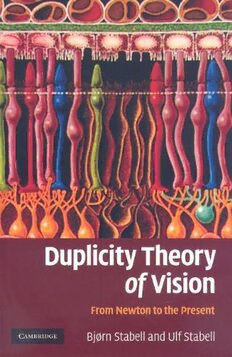
Duplicity Theory of Vision: From Newton to the Present PDF
Preview Duplicity Theory of Vision: From Newton to the Present
This page intentionally left blank Duplicity Theory of Vision The duplicity theory of vision concerns the comparisons (both differences and similarities) and interaction between the cone and rod systems in the visual pathways, with the assumption that the cone system is active during daylight vision and the rod system functions in low light (night vision). Research on this aspect of vision dates back to the seventeenth century and the work of Newton, and is still ongoing today. This book describes the origin and development of this fundamental theory within vision research – whilst also examining the Young-Helmholtz t richromatic colour theory, and the opponent colour theory of Hering – and presents evidence and ideas in the light of modern conceptions of the theory. Written for academic researchers and graduate students, the book reviews knowledge of the tradition of duplicity theory, inspiring questions related to anatomy, comparative biology, molecular biology, photochemistry, physiology, genetics, p hylogenetics and psychophysics. bjørn and ulf stabell have worked in close collaboration on vision research at the Institute of Psychology, University of Oslo, since 1964. For 45 years their research has focussed on questions related to the duplicity theory of vision, publishing over 70 papers. Since 1986, the Stabells have been recipients of State Scholarships of Norway. During the first years of their studies they used a Hecht and Schlaer adaptometer (the 1938 version), being inspired by the papers of P. Saugstad and A. Saugstad (1959) and I. Lie (1963). In 1970 a copy of W. D. Wright’s colorimeter at Imperial College of Science, London, became available at the institute (built by B. Hisdal). Now W. D. Wright’s and J. D. Moreland’s well-known papers became the main focus of their interest. These authors had developed ingenious methods for investigating colour vision in the extrafoveal retina. By using the new Wright colorimeter and by modifying their methods somewhat, it was possible to obtain accurate data on sensitivity and colour vision functions from all regions of the retina, even from its most peripheral parts. Duplicity Theory of Vision From Newton to the Present Edited by bjørn stabell and ulf stabell CAMBRIDGE UNIVERSITY PRESS Cambridge, New York, Melbourne, Madrid, Cape Town, Singapore, São Paulo, Delhi, Dubai, Tokyo Cambridge University Press The Edinburgh Building, Cambridge CB2 8RU, UK Published in the United States of America by Cambridge University Press, New York www.cambridge.org Information on this title: www.cambridge.org/9780521111171 © B. Stabell and U. Stabell 2009 This publication is in copyright. Subject to statutory exception and to the provision of relevant collective licensing agreements, no reproduction of any part may take place without the written permission of Cambridge University Press. First published in print format 2009 ISBN-13 978-0-511-60511-6 eBook (NetLibrary) ISBN-13 978-0-521-11117-1 Hardback Cambridge University Press has no responsibility for the persistence or accuracy of urls for external or third-party internet websites referred to in this publication, and does not guarantee that any content on such websites is, or will remain, accurate or appropriate. To Kirsten and Kari Contents Acknowledgements page xiii 1 Introduction 1 1.1 Roots of the duplicity theory of vision: Ancient Greeks 1 1.2 Further development of the duplicity theory 3 Part I The development of the basic ideas of the duplicity theory from Newton to G. E. Müller 6 2 The Newton tradition 7 2.1 Newton’s universal colour theory 7 2.2 An alternative to Newton’s theories of light and colour 8 2.3 P hototransduction in the retina and signal transmission to the brain: Newton’s speculations 11 2.4 N ewton’s gravitation principle applied to colour mixture data 12 2.5 Conclusions 14 2.6 Young’s colour theory: three instead of seven primaries 14 2.7 Maxwell: triplicity of colour vision proved 16 2.8 Helmholtz: the Young-Helmholtz colour theory 20 3 The Schultze tradition 22 3.1 The duplicity theory of Max Schultze 22 3.2 Evidence in favour of the theory 22 3.3 One or several types of cone? 23 3.4 P hototransduction is photochemical in nature: Boll and Kühne 25 3.5 Boll: discovery of rhodopsin as a visual photopigment 26 3.6 Kühne: several photochemical substances in the retina 27 3.7 Phototransduction of rhodopsin 29 viii contents 3.8 Parinaud and König: early reformulations of the duplicity theory 29 3.9 The duplicity theory of Parinaud 30 3.10 König: rhodopsin is the mediator of night vision – a conclusive proof 32 3.11 The duplicity theory of König 32 3.12 The duplicity theory of von Kries 34 3.13 An attempt to unify the theories of Schultze and Young- Helmholtz 38 4 The Goethe tradition: the phenomenological approach 41 4.1 Phenomenological analysis may reveal underlying material processes 41 4.2 The colour theory of J. W. von Goethe 42 4.3 Goethe’s contribution 44 4.4 The colour theory of Ewald Hering 45 4.5 Experiments in support of Hering’s colour theory 49 4.6 Contributions of Hering 50 5 The colour theories of Armin Tschermak and George Elias Müller 52 5.1 The colour theory of Tschermak 52 5.2 The duplicity theory of G. E. Müller 53 5.3 Evaluation of G. E. Müller’s colour theory 59 Part II T he development of the duplicity theory from 1930–1966 61 6 The duplicity theory of Polyak 62 6.1 Trichromacy of colour vision explained by three types of bipolar cell 63 6.2 Midget ganglion cells as synthesizers 65 6.3 The specific fibre-energy doctrine questioned 65 6.4 Applications of Polyak’s colour theory 66 6.5 Common pathways of rods and cones 67 6.6 E xplanations of acuity and sensitivity differences between rods and cones 69 6.7 The functional potentials of the synaptic arrangement 70
